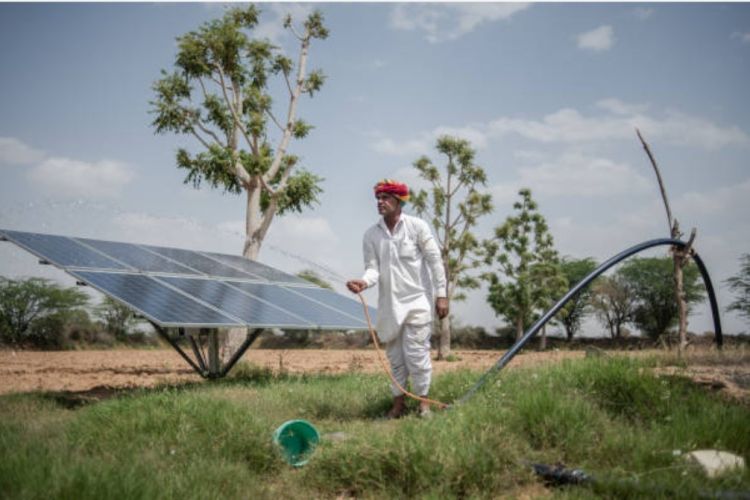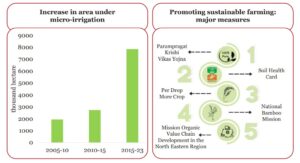
Boosting rural economy: India’s agricultural sector has consistently demonstrated resilience, achieving steady growth over the years despite challenges such as climate change, resource constraints, and market fluctuations. The Economic Survey 2024-25, tabled by Finance Minister Nirmala Sitharaman on Friday, highlights the sector’s significance, lists key trends, government initiatives, and their impact on agricultural growth, farmers’ incomes, and rural development.
The Economic Survey reaffirms that agriculture and allied activities remain vital to the Indian economy, contributing significantly to national income and employment. The sector has witnessed a robust average annual growth rate of 5% from FY17 to FY23, and in the second quarter of FY25, agriculture recorded a 3.5% growth rate. The Gross Value Added in agriculture increased from 24.38% in FY15 to 30.23% in FY23, further consolidating its role in economic stability.
READ | Economic Survey 2024-25 lists India’s strengths, weaknesses
India’s kharif foodgrain production for 2024 is estimated at 1,647.05 LMT, marking an increase of 89.37 LMT compared with the previous year. Agricultural income has grown at an annual rate of 5.23% over the past decade, reflecting the success of various government interventions aimed at enhancing productivity and ensuring fair pricing for farmers.
Government initiatives supporting agriculture
In line with its commitment to farmers, the government has set MSP at 1.5 times the weighted average cost of production since the Union Budget 2018-19. For FY25, significant MSP hikes were announced: arhar and bajra prices increased by 59% and 77%, respectively, while masur and rapeseed MSPs rose by 89% and 98%.

Water availability is crucial for agricultural sustainability. The Economic Survey notes that irrigation coverage expanded from 49.3% of the gross cropped area in FY16 to 55% in FY21. The Per Drop More Crop scheme, under the Pradhan Mantri Krishi Sinchayee Yojana, has facilitated micro-irrigation expansion, covering 95.58 lakh hectares with a total allocation of Rs 21,968.75 crore. Additionally, the Micro-Irrigation Fund (MIF) has approved loans worth Rs 4709 crore, with Rs 3640 crore already disbursed.
Diversifying agricultural income
The livestock sector has emerged as a major growth driver, accounting for 5.5% of GVA, with a CAGR of 12.99%. The Economic Survey highlights key initiatives such as the Rashtriya Gokul Mission and the Livestock Health and Disease Control Programme, ensuring genetic improvement and disease prevention.
Fisheries have also seen impressive growth, with total production reaching 184.02 lakh tonnes in FY23, a significant jump from 95.79 lakh tonnes in FY14. Government schemes like Pradhan Mantri Matsya Sampada Yojana and Fisheries and Aquaculture Infrastructure Development Fund have contributed to this surge.
Boosting agricultural exports and processing
Floriculture, a sunrise industry, recorded a 14.55% export growth in FY25. Similarly, horticultural exports, especially fresh grapes, have strengthened India’s position in global markets. Maharashtra remains the top grape-producing state, accounting for over 67% of total production.
India’s agri-food exports reached $46.44 billion in FY24, with processed food’s share rising from 14.9% in FY18 to 23.4% in FY24. Initiatives like Pradhan Mantri Kisan Sampada Yojana and Production Linked Incentive Scheme for Food Processing have incentivised investments in value-added agricultural products.
To address post-harvest losses, the government is enhancing foodgrain storage infrastructure through steel silos, smart warehouses, and mobile storage units (Flospan) in collaboration with the World Food Programme.
Boosting rural economy
The government looks to improve rural living standards under the Viksit Bharat 2047 vision. The Pradhan Mantri Awaas Yojana-Gramin has facilitated the construction of 2.69 crore houses since 2016, generating substantial rural employment. Additionally, Pradhan Mantri Gram Sadak Yojana has built 8,000 km of roads in tribal and remote areas, improving accessibility.
Programs like the Mahatma Gandhi National Rural Employment Guarantee Scheme (MGNREGS) have ensured wage security for rural workers. DAY-NRLM (Deendayal Antyodaya Yojana – National Rural Livelihood Mission) has enabled self-employment for marginalised communities, expanding its Food, Nutrition, Health, and WASH (FNHW) interventions to 5,369 blocks across 682 districts.
A new government initiative provides drones to Women Self-Help Groups (SHGs) for agricultural services, such as pesticide application. With 80% financial assistance for drone purchases, this program aims to generate at least Rs 1 lakh annual income for SHGs while modernising farming techniques.
Agricultural credit access has significantly improved through initiatives like the Kisan Credit Card (KCC), which now has 7.75 crore active accounts with outstanding loans of Rs 9.81 lakh crore. The Modified Interest Subvention Scheme (MISS) has facilitated over Rs 1 lakh crore in processed claims, reducing reliance on informal lenders. Ground-Level Credit (GLC) to agriculture surged from Rs 8.45 lakh crore in FY15 to Rs 25.48 lakh crore in FY24, benefiting small and marginal farmers.
Food security and PDS modernisation
The Public Distribution System plays a vital role in food security. The One Nation, One Ration Card scheme now ensures nationwide portability of food entitlements, benefiting migrant workers. The government has also strengthened post-harvest financing via the Credit Guarantee Scheme for e-NWR Pledge Financing, enabling small farmers to access loans against warehouse receipts.
The Economic Survey 2024-25 presents a compelling picture of India’s agriculture and rural economy, driven by consistent government interventions in irrigation, financial inclusion, technological innovation, and rural infrastructure development. However, challenges remain, including climate change risks, market volatility, and resource constraints.
Strengthening supply chains, ensuring MSP effectiveness, promoting sustainable practices, and fostering cooperative models will be crucial. By focusing on holistic rural development and inclusive growth strategies, India can achieve its Viksit Bharat 2047 vision, ensuring prosperity for farmers and rural communities alike.
